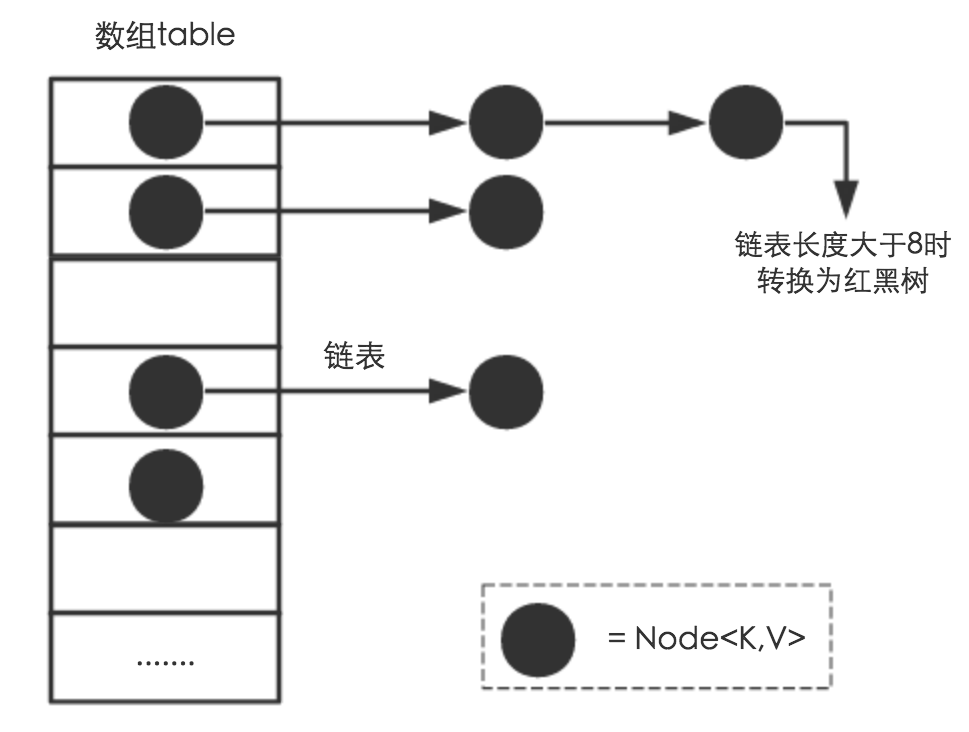基本介绍
- 用于存储Key-Value键值对的集合(每一个键值对也叫做一个Entry)。
- 根据键的hashCode值存储数据,大多数情况下可以直接定位到它的值。
- 键key为null的记录至多只允许一条,值value为null的记录可以有多条。
- 非线程安全。
- HashMap是由数组+链表+红黑树(JDK1.8后增加了红黑树部分,链表长度超过阈值(8)时会将链表转换为红黑树)实现的。
- 新来的Entry节点插入链表时使用的是“头插法”,即会插在链表的头部,因为HashMap的发明者认为后插入的Entry被查找的概率更大。

源码分析
public class HashMap<K,V> extends AbstractMap<K,V> implements Map<K,V>, Cloneable, Serializable {
private static final long serialVersionUID = 362498820763181265L;
//默认的初始容量是16,必须是2的幂。
static final int DEFAULT_INITIAL_CAPACITY = 1 << 4; // aka 16
//最大容量(必须是2的幂且小于2的30次方,传入容量过大将被这个值替换)
static final int MAXIMUM_CAPACITY = 1 << 30;
//默认加载因子
static final float DEFAULT_LOAD_FACTOR = 0.75f;
//阈值:用来确定何时链表转为红黑树
static final int TREEIFY_THRESHOLD = 8;
//用来确定何时红黑树转变为链表
static final int UNTREEIFY_THRESHOLD = 6;
//当想要将解决hash冲突的链表转变为红黑树时,需要判断此时数组的容量,
//若是数组容量太小(64),则不进行链表转为红黑树的操作,而是利用resize()函数对HashMap扩容
static final int MIN_TREEIFY_CAPACITY = 64;
static class Node<K,V> implements Map.Entry<K,V> {
final int hash;
final K key;
V value;
Node<K,V> next;
Node(int hash, K key, V value, Node<K,V> next) {
this.hash = hash;
this.key = key;
this.value = value;
this.next = next;
}
public final K getKey() { return key; }
public final V getValue() { return value; }
public final String toString() { return key + "=" + value; }
public final int hashCode() {
return Objects.hashCode(key) ^ Objects.hashCode(value);
}
public final V setValue(V newValue) {
V oldValue = value;
value = newValue;
return oldValue;
}
public final boolean equals(Object o) {
if (o == this)
return true;
if (o instanceof Map.Entry) {
Map.Entry<?,?> e = (Map.Entry<?,?>)o;
if (Objects.equals(key, e.getKey()) &&
Objects.equals(value, e.getValue()))
return true;
}
return false;
}
}
static final int hash(Object key) {
int h;
return (key == null) ? 0 : (h = key.hashCode()) ^ (h >>> 16);
}
/**
* 数组Table的每一个元素不单纯只是一个Entry对象,它还是一个链表的头节点:
* 每一个Entry对象通过Next指针指向下一个Entry节点。
* 当新来的Entry映射到冲突数组位置时,只需要插入对应的链表位置即可。
*/
transient Node<K,V>[] table;
transient Set<Map.Entry<K,V>> entrySet;
//实际存储的key-value键值对的个数
transient int size;
//HashMap发生结构性变化的次数(value值的覆盖不属于结构性变化)
transient int modCount;
//threshold的值="容量*加载因子",当HashMap中存储数据的数量达到threshold时,就需要将HashMap的容量加倍。
int threshold;
//加载因子实际大小
final float loadFactor;
public HashMap(int initialCapacity, float loadFactor) {
if (initialCapacity < 0)
throw new IllegalArgumentException("Illegal initial capacity: " +
initialCapacity);
if (initialCapacity > MAXIMUM_CAPACITY)
initialCapacity = MAXIMUM_CAPACITY;
if (loadFactor <= 0 || Float.isNaN(loadFactor))
throw new IllegalArgumentException("Illegal load factor: " +
loadFactor);
this.loadFactor = loadFactor;
this.threshold = tableSizeFor(initialCapacity);
}
public HashMap(int initialCapacity) {
this(initialCapacity, DEFAULT_LOAD_FACTOR);
}
public HashMap() {
this.loadFactor = DEFAULT_LOAD_FACTOR; // all other fields defaulted
}
public HashMap(Map<? extends K, ? extends V> m) {
this.loadFactor = DEFAULT_LOAD_FACTOR;
putMapEntries(m, false);
}
public V put(K key, V value) {
return putVal(hash(key), key, value, false, true);
}
final V putVal(int hash, K key, V value, boolean onlyIfAbsent,
boolean evict) {
Node<K,V>[] tab; Node<K,V> p; int n, i;
//判断table是否已初始化,否则进行初始化table操作
if ((tab = table) == null || (n = tab.length) == 0)
n = (tab = resize()).length;
//根据hash值确定节点在数组中的插入的位置,即计算索引存储的位置,若该位置无元素则直接进行插入
if ((p = tab[i = (n - 1) & hash]) == null)
tab[i] = newNode(hash, key, value, null);
else {
//节点若已经存在元素,即待插入位置存在元素
Node<K,V> e; K k;
//判断已存在的元素与待插入元素的hash值和key值是否相等,如果相等则将此节点赋值给e,便于后续覆盖value。
if (p.hash == hash &&
((k = p.key) == key || (key != null && key.equals(k))))
e = p;
//判断该元素是否为红黑树节点
else if (p instanceof TreeNode)
//红黑树节点则调用putTreeVal()函数进行插入
e = ((TreeNode<K,V>)p).putTreeVal(this, tab, hash, key, value);
//若该元素是链表,且为链表头节点,则从此节点开始向后寻找合适的插入位置
else {
for (int binCount = 0; ; ++binCount) {
if ((e = p.next) == null) {
//找到插入位置后,新建节点插入
p.next = newNode(hash, key, value, null);
//若链表上节点超过TREEIFY_THRESHOLD - 1,即链表长度为8,将链表转变为红黑树
if (binCount >= TREEIFY_THRESHOLD - 1) // -1 for 1st
treeifyBin(tab, hash);
break;
}
//判断已存在的元素与待插入元素的hash值和key值是否相等,如果相等则将此节点赋值给e,便于后续覆盖value。
if (e.hash == hash &&
((k = e.key) == key || (key != null && key.equals(k))))
break;
p = e;
}
}
//当key存在时,覆盖value
if (e != null) { // existing mapping for key
V oldValue = e.value;
if (!onlyIfAbsent || oldValue == null)
e.value = value;
afterNodeAccess(e);
//若存在key节点,则更新此节点的value,并返回旧的value。
return oldValue;
}
}
//记录修改次数
++modCount;
//判断是否需要扩容
if (++size > threshold)
resize();
afterNodeInsertion(evict);
//若不存在key节点(插入新key),则返回null
return null;
}
public V get(Object key) {
Node<K,V> e;
return (e = getNode(hash(key), key)) == null ? null : e.value;
}
final Node<K,V> getNode(int hash, Object key) {
Node<K,V>[] tab; Node<K,V> first, e; int n; K k;
if ((tab = table) != null && (n = tab.length) > 0 &&
(first = tab[(n - 1) & hash]) != null) {
if (first.hash == hash && // always check first node
((k = first.key) == key || (key != null && key.equals(k))))
return first;
if ((e = first.next) != null) {
if (first instanceof TreeNode)
return ((TreeNode<K,V>)first).getTreeNode(hash, key);
do {
if (e.hash == hash &&
((k = e.key) == key || (key != null && key.equals(k))))
return e;
} while ((e = e.next) != null);
}
}
return null;
}
public V remove(Object key) {
Node<K,V> e;
return (e = removeNode(hash(key), key, null, false, true)) == null ?
null : e.value;
}
final Node<K,V> removeNode(int hash, Object key, Object value,
boolean matchValue, boolean movable) {
Node<K,V>[] tab; Node<K,V> p; int n, index;
//判断表是否为空,以及p节点根据键的hash值对应到数组的索引初是否有节点
if ((tab = table) != null && (n = tab.length) > 0 &&
(p = tab[index = (n - 1) & hash]) != null) {
Node<K,V> node = null, e; K k; V v;
//若是需要删除的节点就是该头节点,则让node引用指向它
if (p.hash == hash &&
((k = p.key) == key || (key != null && key.equals(k))))
node = p;
//结点在当前p所指向的头节点的链表或红黑树中,需要遍历查找
else if ((e = p.next) != null) {
//若头节点是红黑树节点,则调用红黑树本身的遍历方法getTreeNode,获取待删除的结点
if (p instanceof TreeNode)
node = ((TreeNode<K,V>)p).getTreeNode(hash, key);
//否则就是普通链表,则使用do while循环遍历查找待删除结点
else {
do {
if (e.hash == hash &&
((k = e.key) == key ||
(key != null && key.equals(k)))) {
node = e;
break;
}
p = e;
} while ((e = e.next) != null);
}
}
if (node != null && (!matchValue || (v = node.value) == value ||
(value != null && value.equals(v)))) {
//若是红黑树结点的删除,则直接调用红黑树的removeTreeNode方法进行删除
if (node instanceof TreeNode)
((TreeNode<K,V>)node).removeTreeNode(this, tab, movable);
//若待删除结点是一个头节点,则用它的next节点顶替它作为头节点存放在table[index]中,以此达到删除的目的
else if (node == p)
tab[index] = node.next;
//若待删除结点为普通链表中的一个结点,则用该节点的前一个节点直接跳过该待删除节点,指向它的next结点
else
p.next = node.next;
//记录修改次数
++modCount;
--size;
afterNodeRemoval(node);
//若removeNode方法删除成功则返回被删除的结点
return node;
}
}
//若没有删除成功则返回null
return null;
}
}
HashMap的扩容机制
HashMap的扩容是申请一个容量为原数组大小两倍的新数组:
遍历旧数组,重新计算每个元素的索引位置,并复制到新数组中。
因为HashMap的哈希桶数组大小总是为2的幂次方,So重新计算后的索引位置要么在原来位置不变,要么就是“原位置+旧数组长度”。
扩充HashMap:
复制数组元素及确定索引位置时不需要重新计算hash值,
只需要判断原来的hash值新增的那个bit是1,还是0 ( (h = key.hashCode()) ^ (h >>> 16):减少了碰撞的几率) :
若为0,则索引未改变;
若为1,则索引变为“原索引+旧数组长度”
threshold和loadFactor两个属性决定着是否扩容:
threshold=Length*loadFactor,Length表示table数组的长度(默认值为16),loadFactor为负载因子(默认值为0.75)
阀值threshold表示当table数组中存储的元素个数超过该阀值时,即需要扩容。
